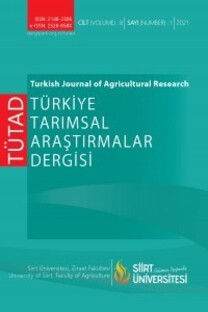Farklı Konsantrasyonlardaki Baldıran (Conium maculatum L. ) Ekstratlarının Myzus percicae (Sulzer) ve Aphis fabae (Scopoli) (Hemiptera: Aphididae) Üzerine Etkileri
Baldıran, Conium maculatum, Myzus percicae, Aphis fabae, kontrol
Effects of Different Concentrations of Hemlock (Conium maculatum L.) Extracts on Myzus persicae (Sulzer) & Aphis fabae (Scopoli) (Hemiptera; Aphididae)
Hemlock, Conium maculatum, Myzus percicae, Aphis fabae, control,
___
- Abbott, W.S., 1925. A method of computing the effectiveness of an insecticide. Journal of Economic Entomology, 18(2): 265-267.
- Arnason, J.T., Philogene, B.J.R., Morand, P., 1989. Insecticides of plants origin. Vol. 387, American Chemical Society Symposium, Washington, DC, USA.
- Brauer, M., Devkota, B., 1990. Control of Thaumatopoea piyocampa (Den.&Schiff) by extracts of Melia azedarach L. (Meliaceae). Journal Applied Enomology, 110: 128-135.
- Capinera, J., 2008. Encyclopedia of Entomology. Springer Netherlands.
- Dancewicz, K., Gabrys, B., 2008. Effect of extracts of garlic (Allium sativum L.), wormwood (Artemisia absinthium L.) and (Tanacetum vulgare L.) on the behaviour of the peach potato aphid Myzus persicae (Sulzer) during the settling on plants. Pesticides, 3-4: 93-99.
- Day, J.W., Moerschbaecher, M., Pimentel, D., Hall, C., Arancibia, A.Y., 2014. Sustainability and place: How emerging mega-trends of the 21st century will affect humans and nature at the landscape level. Ecological Engineering, 65: 33-48.
- Erdoğan, P., Yıldırım, A., 2013. İki farklı bitki ekstraktının yeşil şeftali yaprakbiti (Myzus (N.) persicae Sulzer) (Hemiptera: Aphididae)]’ne insektisit etkileri üzerinde araştırmalar. Bitki Koruma Bülteni, 53(1): 33-42.
- Gaspari, M., Lykouressis, D., Perdikisand, D., Polissiou, M., 2007. Nettle extract effects on the aphid Myzus persicae (Sulzer) and its natural enemy, the predator Macrolopus pygmaeus (Hem.: Miridae). Journal Applied Enomology, 131(9-10): 652-657.
- Görür, G., 2004. Aphid (Homoptera: Aphididae) species on pome fruit trees in Nigde Province of Turkey. Türkiye Entomoloji Dergisi, 28(1): 21-26.
- Griffiths, D.C., Greenway, A.R., Lyoyd, S.L., 2009. The influence of repellent materials and aphid exracts on settling behaviour and larviposition of Myzus persicae (Sulzer). Bulletin of Entomological Research, 68: 613-619.
- Jacobson, M., 1982. Plants, insects, and man-their interrelationships. Economic Botany, 36(3): 346-354.
- Karaca, İ., 2013. Bitki ekstraktlarının sera beyazsineği [Trialeurodes vaporariorum (Westw.) Homoptera: Aleyrodidae]’ne olan toksik ve davranışsal etkileri. Yüksek lisans tezi, Gaziosmanpaşa Üniversitesi, Tokat.
- Kim, D.I., Park, J.D., Kim, S.G., Kuk, H., Jang, M., Kim,S., 2005. Screening of some crude plant extracts for their acaricidal and insecticidal efficacies. Journal Asia-Pasific Entomology, 8(1): 93-100.
- Lai, R., You, M.S., 2010. Antifeedant and toxic avctivities of Allium sativum ethanol extracts against Myzus persicae (Sulzer). Journal of Fujian Agriculture and Foresty, 39(1): 15-18.
- Roy, B., Amin, R., Uddin, M.N., 2005. Leaf extracts of Shiyalmutra (Blumea lacera) as botanical insecticides against lesser grain borrer and rice weevil. Journal of Biological Sciences, 5: 201-204.
- Sevinç, M.S., Eren, U., Akdemir, E., İsmail, K., 2010. Bazı tarımsal savaş ilaçlarının avcı böcek Chilocorus nigritus (Fabricius) (Coleoptera: Coccinellidae) üzerine etkileri. Türkiye Biyolojik Mücadele Dergisi, 1(2): 157-164.
- Şenel, M., 2013. Bazı bitkisel ekstraktların Tuta absoluta (Meyrick, 1917) (Lepidoptera: Gelechiidae)’nın farklı biyolojik dönemlerine etkisi. Yüksek lisans tezi, Adnan Menderes Üniversitesi, Aydın.
- Taş, M.N., Uysal, M., Çetin, H., 2015. Bazı bitki ekstraktlarının Callosobruchus maculatus (F.) (Col.: Bruchidae)’e olan kontak toksisiteleri. Bitki Koruma Bülteni, 55(3): 195-205.
- Velcheva, N., Atanassov, N., Velchev, V., Karadjova O., Velichkova, M., 2001. Toxic action of plant extracts on some pests of economic importance. Bulgarian Journal Agricultural Science, 7: 133-139.
- Warthen, J.D., Morgan, E.D., Mandava, N.B., 1990. Insect feeding deterrents. In: E.D. Morgan and N.B. Mandava (Eds.), Insect Attractants and Repellents, CRC Handbook of Natural Pesticides, CRC Press, Boca Raton, Fla, USA, pp. 23-134.
- Zhou, Q., Liang, O., 2003. Effect of plant alcohol extracts on vegetable aphids and their parasitoids. Ying Yong Tai Xue Bao, 14(2): 249-52.
- Zhou, Q., Liang, G., Zeng, L., Shen, S., Cen, Y., 2005. Controlling effects of plant extracts and pesticides on Myzus persicae and Lipaphis erysimi populations. Ying Yong Tai Xue Bao, 16(7): 1317-1321.
- ISSN: 2148-2306
- Yayın Aralığı: 3
- Başlangıç: 2014
- Yayıncı: SİİRT ÜNİVERSİTESİ ZİRAAT FAKÜLTESİ
Samsun İlinin Newhall Modeline Göre Toprak Sıcaklık ve Nem Rejimlerinin Belirlenmesi
Mümin TURAN, Orhan DENGİZ, İnci DEMİRAĞ TURAN
Siklofosfamid Nedenli Hematoksisite Üzerine Karvakrolün Sitoprotektif Etkileri
Mustafa CENGİZ, Öznur YEŞİLDAĞ, Adnan AYHANCI
Muscari botryoides (L.) Mill.: A New Record for the Family Asparagaceae from Turkey
Süleyman Mesut PINAR, Mehmet FİDAN, Hüseyin EROĞLU
Bilal AYDINOĞLU, Sadık ÇAKMAKÇI
Bitkilerde Sinyal Molekülü Hidrojen Sülfür (H2S)
Bakırla Kirlenmiş Toprakların Xanthium strumarium L. Bitkisi Kullanılarak Fitoremediasyonu
Hawraz Dhahir OTHMAN, Mustafa Cemal ÇİFTÇİ, Erdem SEVEN
